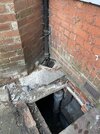I have a rear gully which is leaking and I think is responsible for the damp on an internal spine wall.
I need to dig out the gully and want to move it to the right so it is a bit more away from that corner.
This house was converted into flats in 1965 so I think the drain set up was changed then. Originally there was a door into the cellar next to the old clay pipe.
Question: what coupling do I use to connect into the clay pipe. I want to connect when it is in the vertical position and then I will add backwards in plastic. I will probably do the last leg of the downpipe in plastic as well and angle it at 45 degrees to the right.
My other worry is, could the soil pipe wedged in the corner also connect into this gully and so use the large clay pipe? Or will that go all the way to the bottom and hit the floor with its own pipe?
I need to dig out the gully and want to move it to the right so it is a bit more away from that corner.
This house was converted into flats in 1965 so I think the drain set up was changed then. Originally there was a door into the cellar next to the old clay pipe.
Question: what coupling do I use to connect into the clay pipe. I want to connect when it is in the vertical position and then I will add backwards in plastic. I will probably do the last leg of the downpipe in plastic as well and angle it at 45 degrees to the right.
My other worry is, could the soil pipe wedged in the corner also connect into this gully and so use the large clay pipe? Or will that go all the way to the bottom and hit the floor with its own pipe?




